IoT Deployments Need Careful Planning and Execution, Not Rush Jobs
Businesses are increasingly going more digital because they realize it's no longer much of a choice. IoT deployments are part of this digital transformation, but not all smart technology lives up to its name. Rushing IoT projects is a mistake that can lead to a snowball effect of multiple misfortunes, so it's best to put plenty of time into planning and executing IoT projects. Many businesses turn to tech consultants to minimize the complications that come with digital transformation.
Why IoT Systems Fail
Not all IoT deployments are successful, as some companies have dealt with hundreds of failed attempts to digitize parts of their infrastructure. According to Beecham Research, 58 percent of businesses surveyed said their IoT projects were unsuccessful, while only 12 percent boasted complete success.
IoT technology is about delivering valuable operational data in real time. Even though IoT has come a long way in a short time, it still presents deficiencies in certain applications. Poor planning and weak execution are two major factors for IoT system failures.
One of the keys for businesses to overcome major IoT challenges is to envision resilience through a complex transformation. It's important to realize IoT is still in its infancy and it has limitations, especially when it comes to cheaper products. The medical industry has succeeded with going wireless and digital because it contracts with advanced companies that design high-quality electronic products. Local governments have also invested in advanced technology to design "smart cities."
Many companies have set up their new infrastructures so that all data goes to a database in the cloud. But if they lack a filtering system to weed out spam and unnecessary data, the system can get cluttered with a mix of useful and useless big data. That's where an IT consultant can offer direction on steps to minimize the storage of useless data, as well as other proactive measures to improve efficiency.

Explore the state of IoT and how it is used with other advanced technologies by purchasing a ticket for our on-demand event, the Summit of Things.
Reasons Why IoT Deployment Isn't Simple
Shifting to a digital infrastructure implanted with IoT devices is easier said than done, even for seasoned technicians. There are many technical challenges involved, which is why companies outsource to IT experts. Typical software programmers specialize in certain programming languages, but many are not up to date on developing IoT software. So you shouldn't just hire any software developer for your projects.
One of the main reasons to deploy an IoT device is to generate real-time data that can be used to make quick, actionable decisions. If network resources get strained, data transmission might slow down. With medical devices, hospitals need data to transmit in real time, which requires an investment in robust networking. Companies that try to cut corners by buying cheaper but less reliable technology can face serious complaints during network bottlenecks.
A major complexity involved with IoT deployment is getting systems to work with a multitude of components. Another problem with IoT is that it can't replace humans completely, so it needs to be downplayed as a job-destroyer. The problem with CTOs and CIOs who haven't learned much yet about smart technology is they can mislead their companies into either jumping in too fast or resisting IoT completely.
Cybersecurity is another complex issue that involves creating several layers of security, otherwise IoT sensors can be compromised by hackers. Even the most sophisticated cybersecurity systems can be vulnerable to a technically-skilled cybercriminal. Your company data can be exploited in many ways by nefarious players of the dark web. So you need an experienced IT team to handle the difficult tasks of digital transformation.
Sensors Spread Globally
The growth of IoT sensors around the world is expected to be exponential over the next decade. With data expansion comes deeper responsibilities of protecting the data from getting into the wrong hands. In order to move forward with digital transformation, it's crucial for businesses to choose the right tech partner that keeps up with IoT and cybersecurity advancements.
Companies face major risks when they turn IoT projects over to young technicians who lack expertise in the field of smart technology. There are plenty of newbies who want to make money off new technology, but it's not really a job for a computer science graduate who is fresh out of college unless they have deep experience with IoT deployment.
The most common reasons businesses are adopting IoT are related to improving business efficiency, according to Beecham. Top reasons include strengthening safety and security, as well as cutting operational costs. Deploying IoT also enables new business models and opens the door for disruptive players to enter the market.
An interesting insight from Beecham's study is companies that experienced lack of cohesion during IoT deployment tended to see the project fail. Meanwhile, firms that sensed cohesion had a higher rate of success in deploying IoT devices. Lack of experience in communicating with different departments can cause friction in the deployment process. Different departments have different views on what types of data they want to monitor.
It's best to work with tech professionals who understand how to communicate technical language to different types of clients. When you rely on an in-house tech team that doesn't stay ahead of the curve on new tech developments, it can create roadblocks to implementing smart technology. But a third-party tech team that has worked with various businesses on digital transformation can deliver more reliable results and get the project successfully completed on schedule.
Conclusion
Network latency can happen even with modern IoT devices, which defeats the purpose of collecting real-time data. But the more you gain insights from tech experts, the more you'll balance price with quality when it comes to investing in new digital technology. It helps to work with tech professionals to learn more about IoT deployments and deeper information on digital transformation.
